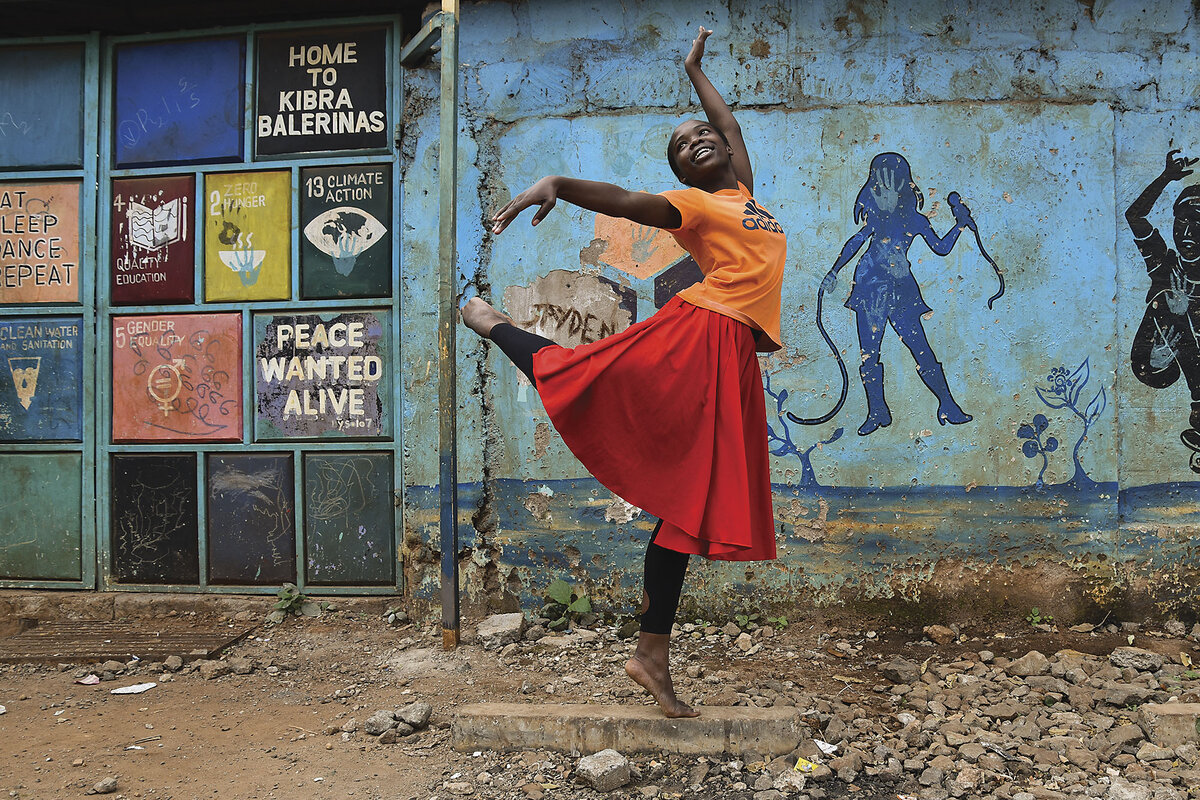ãSomething to tap intoã: Ballet school shows Kenyans that dance is for everyone
Loading...
| Nairobi, Kenya
Sandwiched between mudbrick houses with rusted roofs sits a building painted in vivid orange, coral, and green.
ãEat, Sleep, Dance, Repeat,ã reads a sign at the entrance.
Inside, young children in bathing suits and pajamas pirouette to a Fleetwood Mac song. Their mentor, Mike Wamaya, walks among the dancers, offering high-fives.ô
Why We Wrote This
Ballet has long been associated with elite society. But in an informal settlement in Kenya, one dance teacher has a more inclusive version of the art form.
For him, there is nothing out of the ordinary about kids from this neighborhood dancing ballet. ô
ãDance is for everyone,ã he says. ãIt was given to me for free, so I give it for free.ã
A former professional dancer, Mr. Wamaya has helped bring ballet to Nairobiãs Kibera settlement, which is home to hundreds of thousands of people crowded into an area only 1.5 square miles in size.
ãKibera is so poor, but there is so much talent and resilience here,ã he says. ãWe set up a ballet school that ... show[s] the world there is something to tap into.ãô
ãA unifying thingã
Mr. Wamayaãs path to ballet was a winding one. Growing up in western Kenya, he was forced to drop out of high school after his father died. He worked as a mechanic to support his family.
As he walked to the garage one morning, he saw a poster advertising auditions for the , which trains youths from across the country in dance and theater. Mr. Wamaya was interested in the arts, but had never danced seriously. ãI thought, why not,ã he laughs. ãLet me try it.ã He skipped work and auditioned the same day.ô
To his surprise, he won a scholarship to study at KPAG in Nairobi, where he trained in ballet as well as modern dance and physical theater. He loved the big city. ãIf you can make it in Nairobi, then you can survive anywhere,ã he says.
Mr. Wamaya never returned to school, but says dancing kept him grounded and gave him a sense of purpose and discipline. ãI became who I am now,ã he explains.
Then he went to Europe, where he performed on stages from the United Kingdom to Belgium. ô
In 2007, Mr. Wamaya returned to Kenya to vote in a presidential election. But in the weeks that followed, over the disputed result. All told, as many as 600,000 people were displaced from their homes, thousands injured, and more than 1,000 killed.ô
Wondering how to help his homeland, Mr. Wamaya decided to decline an offer to return to the international dance circuit. ãI didnãt feel useful there,ã he shrugs.ô
Instead, he began teaching dance with nongovernmental organizations in Kibera and other informal settlements in Nairobi.ô
ãDance is a unifying thing,ã he explains. ãPeople dance at weddings. People dance at funerals. People dance when a child is born.ã
In 2017, Mr. Wamaya opened Kibera Ballet School. It is one part of Project Elimu, which takes its name from the Swahili word for education and also offers skateboarding, drumming, and art lessons. Mr. Wamaya wanted to inspire residents and outsiders alike to see Kibera in a new light.
ãSlum is in the mind,ã he says.
Learning to rebound
Walking down Kiberaãs claustrophobic streets, Mr. Wamaya pauses to greet the parents of his pupils.
ãI know everyone,ã he jokes.ô
In a clapboard stall, Clemence Dinah, the mother of one of Project Elimuãs hundreds of graduates, braids hair. Since learning dance from Mr. Wamaya, her daughter Mitchelle has won scholarships to private schools in Kenya, and was recently accepted to the College of Charleston in South Carolina.ô
ãMitchelle has done so much,ã Ms. Dinah says. ã[Dance] kept her busy. She was not exposed to life here.ãô
Back at Project Elimu, a group of Mr. Wamayaãs charges is lining up for breakfast. This is the start of every Saturday morning at the center. It is a safe place for anyone who needs it, Mr. Wamaya says.ô
After eating, the youngest children line up for ballet class, with teenage students leading the lessons. ãThey learn repetition, they learn failing is OK, and if I fail today, tomorrow Iãll pick it up again, and Iãll do it,ã Mr. Wamaya says.
The older dancersã turn to rehearse comes after lunch. On this day in July, they are practicing for an annual dance showcase that was to be held on Aug. 24 at the Kenya National Theatre.
Using a phonetic spelling for the settlement, Mr. Wamaya has named the show ãKibra Rising.ã
A hopeful future
Mr. Wamaya folds his arms and watches carefully as the performers rehearse a dance number he choreographed to the song ãSisi Ndio Futureã ã Swahili for ãWe Are the Futureã ã by Kenyan singer Fari Athman. The song became popular as young people took to the streets to protest a controversial finance bill in 2024.ô
Mr. Wamaya created the dance in a single day this past June after at least 65 people died in another round of anti-government demonstrations.
ãThis piece is a small way of showing the anger and the frustrations we have,ã he says.ô
The song begins mournfully as the students step toward each other in pairs, wrapping their arms around each otherãs necks to represent recent violence. Then the music swells, and the song becomes more hopeful.
It is a favorite of Daisy Achieng, who at 18 has been dancing with Project Elimu for nearly half her life. Soon, she hopes to begin nursing school.
But she says she will not stop doing ballet, which she values for how it transports her out of her ordinary life.ô
On the dance floor, she says, ãI am another person.ãô







